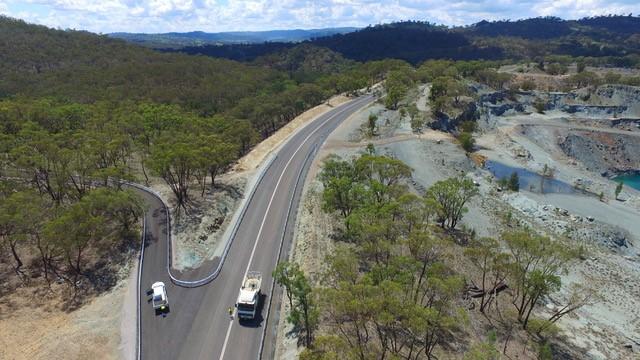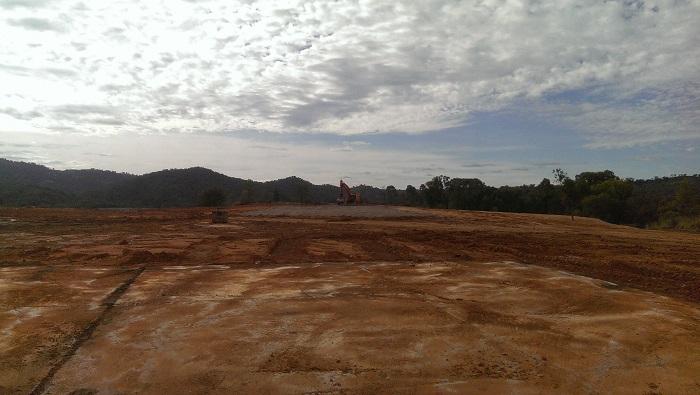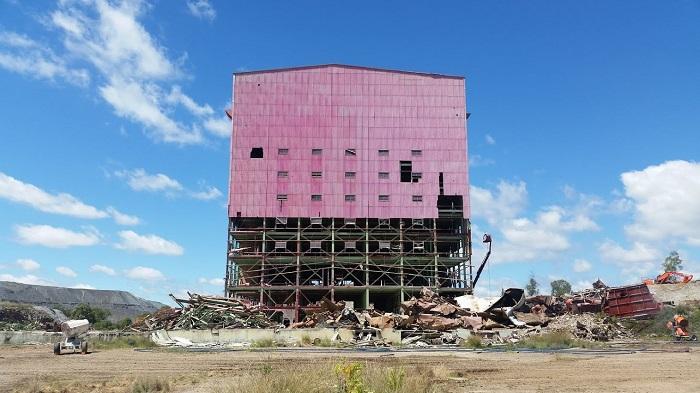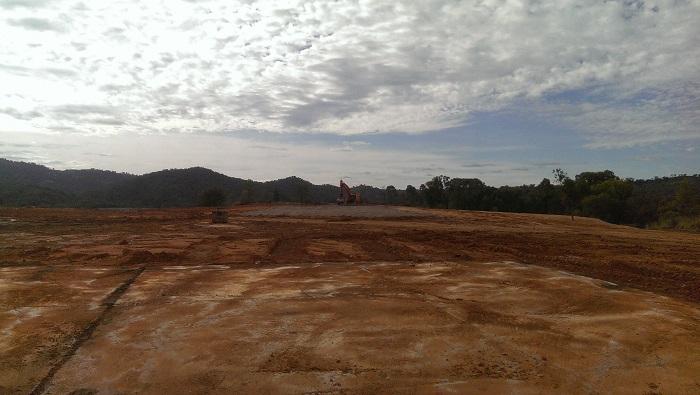Woodsreef Mine
$2 million further remediation works completed

More than 16,000 square metres of road has been prepped, primed and sealed as part of further remediation works to Woodsreef Mine, a legacy asbestos mine in the NSW Northern Tablelands.
Alongside road works, security barriers and fencing were installed in key locations to reduce risk of unauthorised access to the mine site. Areas of road erosion were addressed, and sediment stabilisation activities carried out.
A picnic shelter along the road was also removed and public safety signage installed.
The three-month works were completed in late October 2018 at a cost of $2,119,124. The works were a joint accomplishment by Tamworth Regional Council and NSW Soil Conservation Service funded by the Legacy Mines Program.
Woodsreef Mine is a legacy asbestos mine in the NSW Northern Tablelands.
Open cut mining for asbestos first occurred at Woodsreef from 1919 to 1923.
The Chrysotile Corporation of Australia carried out large scale mining at Woodsreef between 1970 and 1983. Approximately 500,000 tonnes (t) of chrysotile, or white asbestos was produced from 100 million tonnes (Mt) of mined material.
The former mine extends over an area of approximately 400 hectares. The site comprises a 75 million tonne waste rock dump, a 25 million tonne tailings dump and several open pits, some containing considerable quantities of water. Previously there were also several derelict buildings on the site, including an eight-story mill building.
The remediation of Woodsreef Mine has been conducted through the Legacy Mines Program (formerly the Derelict Mines Program). The Legacy Mines Program was part of the Department of Industry until April 2017, when it was moved to the Department of Planning and Environment as part of Machinery of Government changes.
Woodsreef Mine major rehabilitation project
In 2011, the NSW Government provided funding of $6.3 million across three financial years to address the most significant health, safety and environmental issues at the Woodsreef Mine, including:
- the containment of processed friable chrysotile asbestos
- removal of the mill building, silos, and administration buildings
- implementation of a comprehensive air quality monitoring program and health risk assessment before, during and following remediation works
- closure of Mine Road, Woodsreef.
Woodsreef taskforce
The Woodsreef Taskforce was established by the Premier in 2008. The multi-agency committee comprises representatives from NSW Department of Industry (changed to the Department of Planning and Environment in 2017); Ministry of Health; Environment Protection Authority; WorkCover NSW; Hunter New England Health and Crown Lands.
Works undertaken
Demolition works
On 28 March 2011, NSW Department of Industry engaged NSW Public Works to project manage the demolition works.
The demolition works included a planning phase that was extended to allow for additional assessment/studies relating to the threatened Large-eared Pied Bat roosting in the mill building. The Large-eared Pied Bat is listed as a threatened species under the NSW Threatened Species Conservation Act 1995 and the Commonwealth Environmental Protection and Biodiversity Act 1999. The Commonwealth Department of the Environment approved the demolition of infrastructure and to rehabilitation works at the legacy mine on 4 July 2014.
On 3 June 2015 all demolition works were completed eight weeks ahead of the 32 week schedule and within budget.
All demolition works were carried out in accordance with Work Health & Safety Act and Environmental Management Plans in consultation with WorkCover NSW and the Environmental Protection Authority (EPA). This included regular independent audits, carried out to verify the contractor's compliance with safety and environmental requirements.
There were no safety incidents during the 24 week construction period, and a comprehensive air monitoring program undertaken by an Independent Licensed Asbestos Assessor for the duration of site works confirmed there were no off site impacts.
As per the plan, the legacy buildings and infrastructure were demolished and buried on site within an EPA approved engineered containment cell. Some structural steel from within the Mill Building was recycled following a decontamination process which was verified by an Independent Licensed Asbestos Assessor.



Drainage Works
NSW Department of Industry and the Soil Conservation Service conducted a comprehensive Sediment Movement Assessment of the site. Soil Conservation Services has completed the drainage works program. The priority of the works was to ensure that sediment containing asbestos remains on site.
Signage and security
A key initiative of the Woodsreef Taskforce was completed with the erection of the asbestos warning signs for motorists approaching the mine site. The signs describe mitigation measures which will lessen the exposure risk for the travelling public. After numerous episodes of vandalism of the warning signs, the Woodsreef Taskforce worked with local authorities to ensure their continued re-installation.
NSW Crown Lands has implemented additional security measures for the mine site including installation and maintenance of perimeter signage, and regular inspections of the perimeter fence and main access points.
Community consultation
The Woodsreef Community Advisory Group (WCAG) was established to run for a two-year period as part of the Woodsreef Mine Major Rehabilitation Project. The group was established to oversee:
- the demolition of the dilapidated eight story mill house, silos and administration building
- identification and management of stockpiled hazardous asbestos products around the mine
- selection of sites for the comprehensive air quality monitoring program and health risk assessment.
The demolition and containment of the stockpiled asbestos was finalised in June 2015. As the terms of reference for the WCAG were met the group was then dissolved. The Woodsreef Taskforce would like to thank the Community Representatives for their valuable contribution to the WCAG and the Project.
The NSW Government continues to consult with the community around this site via a broader consultation program with the Barraba and Woodsreef communities. As part of this, members of the Woodsreef Taskforce attended several drop-in sessions in August 2018 to discuss the findings of Air Monitoring & Health Risk Assessment Project with the local community.
For further information contact derelict.mines@planning.nsw.gov.au.
Air monitoring & health risk assessment project
The NSW Department of Planning and Environment, Division of Resources and Geoscience commissioned SLR Consulting Australia Pty Ltd to conduct an Air Monitoring and Health Risk Assessment Project to determine if there are any public health implications from potential asbestos exposure at the Woodsreef Mine, NSW.
The project:
- identified and ranked the sources of asbestos on the mine site looking at the potential for off-site migration of asbestos
- assessed the risks to health from the demolition of the Mill Building and associated onsite infrastructure
- modelled air dispersion at various locations surrounding the site
- compared asbestos air data collected from off-site locations with data from another unconnected location with naturally occurring asbestos
- conducted personal air monitoring on recreational activities that are conducted adjacent to the mine site.
The data and information gathered from the above activities were combined to inform the final Long-Term Health Risk Assessment Report.
This assessment concluded that the long term exposure risk is likely to be negligible to low, for communities adjacent to Woodsreef and people who may have intermittent access to areas adjacent to the mine.
However, unauthorised access to the mine site can increase this risk. A significant amount of asbestos bearing rock remains on site and it can pose a risk if disturbed.
The report recommends limiting public access to the site and minimising off-site migration of asbestos containing materials such as waste rock and tailings.
A number of additional mitigation measures have been implemented to reduce the risk to users of the Barraba-Bundara Road, including sealing the road verge, fencing and asbestos warning signs.
The final report was released to the community in July 2018, and on-going air monitoring measures will be put in place by the end of the year.
The NSW Government continues to consult with the community around this site via a broader consultation program with the Barraba and Woodsreef communities.
For more information on the findings of the report see the Air Monitoring and Health Risk Assessment Project fact sheet (PDF, 61.96 KB).

relationship and dependencies of all six reports.
Air monitoring & health risk assessment reports
Woodsreef Hazard Identification Assessment Report Dec 2014 (PDF, 21.31 MB)
Woodsreef Health Impact Assessment Pre-Remediation Sep 2015 (PDF, 3.56 MB)
Woodsreef Health Impact Assessment During Remediation Dec 2016 (PDF, 29.75 MB)
Woodsreef Health Impact Assessment After Remediation Oct 2017 (PDF, 16.76 MB)
Woodsreef Asbestos Exposure During Recreational Activities Human Health Risk Assessment Apr 2017 (PDF, 4.44 MB)
Woodsreef Long Term Health Risk Asessment Oct 2017 (PDF, 10.57 MB)
Woodsreef Mine Major Rehabilitation Project Air Monitoring & Health Risk Assessment Reports (PDF, 10.57 MB)
Further information
2017 EPBC Annual Compliance Report and Attachments (PDF, 49.79 MB)
Woodsreef Mine Major Rehabilitation Project FAQs (PDF, 67.93 KB)
Air Monitoring and Health Risk Assessment Fact Sheet (PDF, 61.96 KB)
Environmental Approval Process for the Woodsreef Mine Major Rehabilitation Project (PDF, 27.85 KB)